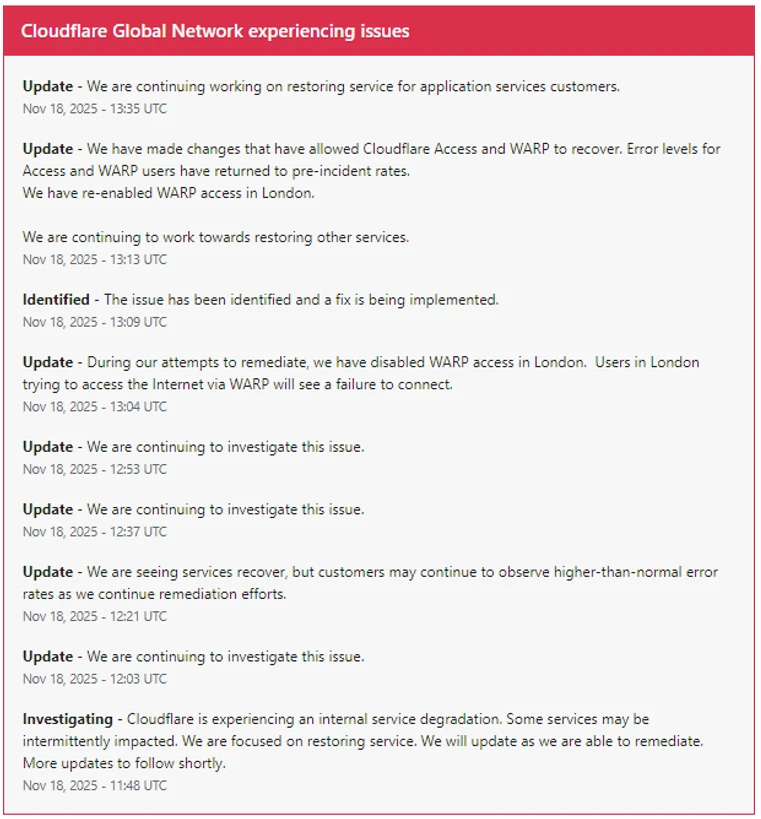The internet experienced a massive disruption on 18 November 2025, as infrastructure giant Cloudflare suffered a global network failure that took down thousands of websites and services. Users worldwide found themselves staring at error messages instead of their favourite platforms.
Social media platform X, AI chatbot ChatGPT, design tool Canva, and even the outage tracker Downdetector itself went dark. The irony wasn’t lost on frustrated users who couldn’t even report the problems they were experiencing.
The Scale of Digital Devastation
The outage began around 11:48 UTC when Cloudflare confirmed widespread 500 errors across its dashboard and API. What started as isolated reports quickly escalated into a full-blown crisis affecting millions globally.

The impact was staggering:
- X (formerly Twitter) saw over 11,500 outage reports within hours
- OpenAI’s ChatGPT and Sora became completely inaccessible
- League of Legends and Valorant gamers found themselves locked out
- Payment platforms PayPal and Uber Eats experienced intermittent failures
- Crypto exchanges including BitMEX reported service disruptions
- Design platform Canva left creative professionals stranded
The Downdetector Paradox
Perhaps the most frustrating aspect? Downdetector, the website millions rely on to check if services are down, was itself offline due to its dependence on Cloudflare Dataconomy. Users attempting to report the Cloudflare outage were greeted with blank screens.
This highlighted a critical vulnerability. When the internet’s infrastructure provider fails, even the tools designed to monitor such failures become useless.
What Went Wrong?
Cloudflare had scheduled maintenance across multiple data centres including Santiago, Tahiti, and Los Angeles on 18 November. While routine maintenance typically proceeds seamlessly, something went catastrophically wrong.
The company acknowledged experiencing “internal service degradation” affecting its global network. Tests revealed Cloudflare nodes across Europe were down, including those in Bucharest, Zurich, Warsaw, Oslo, Amsterdam, Berlin, Frankfurt, Vienna, Stockholm, and Hamburg.
Users encountered three main error types:
- 500 Internal Server Errors: Generic failures preventing page loads
- 502/504 Bad Gateway Errors: Connection failures between servers
- Infinite loops: Browser verification checks stuck endlessly
The London Lockdown
In a desperate remediation attempt, Cloudflare disabled WARP access in London. This meant users in the British capital trying to access the internet via WARP saw complete connection failures.
WARP is Cloudflare’s tool for securing internet connections by encrypting traffic from user devices. Disabling it represented a drastic measure to restore broader service functionality.
Recovery Begins
By 13:09 UTC, Cloudflare reported identifying the issue and implementing a fix. The company warned users to expect some turbulence as the solution proliferated across the internet.
Cloudflare stated services were recovering, but customers might continue observing higher-than-normal error rates during remediation efforts.
Reports on Downdetector began dropping from a peak of 11,201 to around 6,570, suggesting the fix was taking effect. However, the recovery remained patchy for many users.
A Fragile Digital Ecosystem
This incident exposed the precarious nature of modern internet infrastructure. Cloudflare’s global network comprises distributed infrastructure across 330 cities in over 120 countries, with 449 Tbps capacity connecting to over 13,000 networks.
When such a critical provider stumbles, the cascading effects are immediate and widespread. Similar to the recent AWS outage that disrupted services last month, these incidents raise questions about internet resilience.
Industry experts noted that this represents the second major infrastructure outage in recent weeks, following an Amazon Web Services failure that also took significant portions of the internet offline.

Error 500 internal server error screenshot
The Business Impact
The outage affected businesses across sectors:
- E-commerce: Online retailers lost sales during peak hours
- Gaming: Professional esports matches faced disruption
- Finance: Crypto trading platforms saw volume drops
- Productivity: Remote workers couldn’t access cloud tools
- Entertainment: Streaming and social media engagement plummeted
Cloudflare shares (NET) slipped 3.5% in pre-market trading following the incident, reflecting investor concerns about reliability.
What Users Saw
The most common error message read: “Please unblock challenges.cloudflare.com to proceed.” This generic message confused millions who hadn’t blocked anything. The security systems Cloudflare provides simply weren’t functioning, even though protected websites remained operational in the background.
Also Read: Rio Tinto Slashes Yarwun Production as 180 Workers Face Uncertain Future
Looking Ahead
Cloudflare previously mitigated a major outage in June 2025 that caused Zero Trust WARP connectivity issues and Access authentication failures across multiple regions. The company also dealt with DNS failures affecting its AWS platform in October.
The recurring nature of these incidents suggests the need for improved infrastructure resilience. As businesses become increasingly dependent on cloud services, single points of failure pose existential risks.
This latest disruption serves as a stark reminder that despite technological advances, the internet remains surprisingly fragile. When one company’s network stumbles, millions feel the impact instantly.
As Cloudflare continues restoring full service, questions linger about how to build more robust infrastructure for our interconnected digital world.












